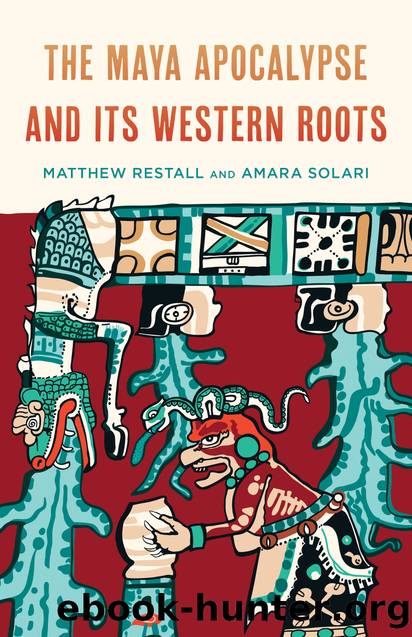The Maya Apocalypse and Its Western Roots by Matthew Restall;Amara Solari; & Amara Solari

Author:Matthew Restall;Amara Solari; & Amara Solari
Language: eng
Format: epub
Publisher: Rowman & Littlefield Publishing Group, Inc.
Published: 2021-08-08T00:00:00+00:00
It is easy to see how this monument has been used, more than any other Aztec text, sculpture, or art, to illustrate the supposed millenarianism of the Aztecs. It does refer to the Aztec idea of previous eras of creation, each of which was destroyed rather violently. But nowhere on the monument (nor anywhere in any form or expression of Aztec culture) is there evidence that the world would not begin anew.
In fact, the very ideology of time as a series of cycles marked inevitably by renewal is represented elsewhere in the monument itself. In addition to the four dates described above, two other dates are carved on the monument. The date 1 Flint Knife, located near the middle of the image, had both cosmological and political importance to the sculptureâs Aztec audience: it referenced the time when the Aztecs began their migration from their mythological place of origin, Lake Aztlan, and was also the date (in 1428) when they defeated a rival Basin of Mexico population (the Tepanecs), allowing the Aztecs to ascend to power. The other additional calendrical date, 13 Reed, refers both to the creation date of the current world and to the moment when the first Aztec emperor, Itzcoatl, ascended to the throne by defeating another rival city-state in the Basin, Azcapotzalco.
The purpose of these pairings is transparently political and decidedly not apocalyptic; Aztec imperial ideology was well-developed, sophisticated, and âsoldâ to the empireâs subjects in multiple complex packages, the Calendar Stone being just one example. The references to 1 Flint Knife and 13 Reed linked mythical events from the deep past, or mythistory, to military and political triumphs achieved recently and locally by the Aztecs; the empireâs rulers thereby claimed that Aztec hegemony was as much a fact of lifeâand just as legitimateâas the world itself. The message was: Aztec rule is an integral facet of the current world, as it should be; this world is not about to end; on the contrary, it and its rulers are here to stay, to see out the cycle andâthink of the New Fire Ceremonyâto not only survive but also manage the transition to the next cycle.
One final point about the misuse of the Calendar Stone: it has been appropriated to illustrate calendar-based millenarianism not only among the Aztecs but also among the Maya. The stone adorned 2012 books, novels, websites, and a multitude of other graphic formats. We have already seen two such examplesâthe newspaper illustration that is our figure 2.4 and the Bizarro cartoon that is our figure I.1; the fact that the Calendar Stoneâs misuse in the cartoon is irrelevant (the joke still works) reflects how common the misappropriation of the image has become. But, of course, the Calendar Stone has no bearing on anything Maya. Aztec and Maya cultures are both part of Mesoamerican civilization, but they are separate and distinct from each other. The Calendar Stone was carved in the Basin of Mexico (possibly in 1479, but probably during Moctezumaâs reign of 1502â1520),
Download
This site does not store any files on its server. We only index and link to content provided by other sites. Please contact the content providers to delete copyright contents if any and email us, we'll remove relevant links or contents immediately.
| Africa | Americas |
| Arctic & Antarctica | Asia |
| Australia & Oceania | Europe |
| Middle East | Russia |
| United States | World |
| Ancient Civilizations | Military |
| Historical Study & Educational Resources |
The Daily Stoic by Holiday Ryan & Hanselman Stephen(2708)
The Fate of Rome: Climate, Disease, and the End of an Empire (The Princeton History of the Ancient World) by Kyle Harper(2436)
People of the Earth: An Introduction to World Prehistory by Dr. Brian Fagan & Nadia Durrani(2346)
Ancient Worlds by Michael Scott(2103)
Babylon's Ark by Lawrence Anthony(2070)
Foreign Devils on the Silk Road: The Search for the Lost Treasures of Central Asia by Peter Hopkirk(2056)
India's Ancient Past by R.S. Sharma(1987)
MOSES THE EGYPTIAN by Jan Assmann(1972)
The Complete Dead Sea Scrolls in English (7th Edition) (Penguin Classics) by Geza Vermes(1840)
Lost Technologies of Ancient Egypt by Christopher Dunn(1797)
The Daily Stoic by Ryan Holiday & Stephen Hanselman(1768)
The Earth Chronicles Handbook by Zecharia Sitchin(1744)
24 Hours in Ancient Rome by Philip Matyszak(1678)
Alexander the Great by Philip Freeman(1648)
Aztec by Gary Jennings(1545)
The Nine Waves of Creation by Carl Johan Calleman(1520)
Curse Tablets and Binding Spells from the Ancient World by Gager John G.;(1510)
Before Atlantis by Frank Joseph(1484)
Earthmare: The Lost Book of Wars by Cergat(1468)
